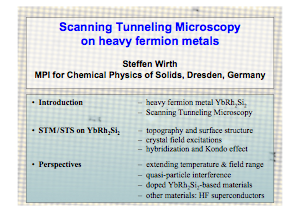Institute of Physics, Chinese Academy of Sciences


Jan 07-09, 2012

Scanning Tunneling Microscopy on heavy fermion metals
Steffen Wirth
Max-Planck-Institute for Chemical Physics of Solids, Dresden, Germany
Heavy fermion metals are often characterized by a variety of relevant energy scales and competing interactions which may result in such fascinating phenomena as quantum criticality and unconventional superconductivity. Therefore, these materials have advanced to suitable model systems by means of which electronic interactions can be studied in detail. Here, we focus on results obtained by Scanning Tunneling Microscopy and Spectroscopy (STM/S).
YbRh2Si2 and its doped counterparts Yb(Rh1−xMx)2Si2 (M = Co, Ir) are of specific topical interest due to a quantum critical point which appears to result not only from an antiferromagnetic instability but also from a Kondo breakdown of the heavy quasiparticles [1]. We present very recent STM and STS at low temperature conducted on YbRh2Si2 [2]. The topography confirms an excellent low-temperature cleave of the single crystals. The hybridization of conduction and 4f electrons results in a gap-like feature of the tunneling conductance. Importantly, the crystal field excitations are unambiguously reflected by STS for the first time. A strongly temperature dependent peak in tunneling conductance is attributed to a resonance resulting from the Kondo lattice.
In the CeMIn5 class of compounds the relation between superconductivity and antiferromagnetism will be discussed [3]. Magnetotransport measurements on CeIrIn5 indicated a precursor state to superconductivity. A gap detected by low-temperature STS in CeCoIn5 is compatible with dx2−y2 symmetry of the superconducting order parameter and is, again, consistent with a precursor state to superconductivity.
We will discuss the possible future impact of real-space electronic structure imaging on the investigation of strong electronic correlations, specifically with respect to coherence phenomena, phase coexistence and quantum criticality. Equally important appears the combination of atomically resolved STM with other structural investigations to elucidate the influence of the local crystalline structure on the overall physical properties of heavy fermion materials.
[1] S. Friedemann et al., Proc. Natl. Acad. Sci. USA 107 (2010) 14547.
[2] S. Ernst et al., Nature 474 (2011) 362.
[3] S. Nair et al., Proc. Natl. Acad. Sci. USA 107 (2010) 9537.

click the picture to download
contact
Yi-feng Yang, Institute of Physics, Chinese Academy of Sciences, P. O. Box 603, Beijing 100190, China. Tel: (86)-10-82649448, (86)-18911600270; Fax: (86)-10-62553698; Email: yifeng@iphy.ac.cn


